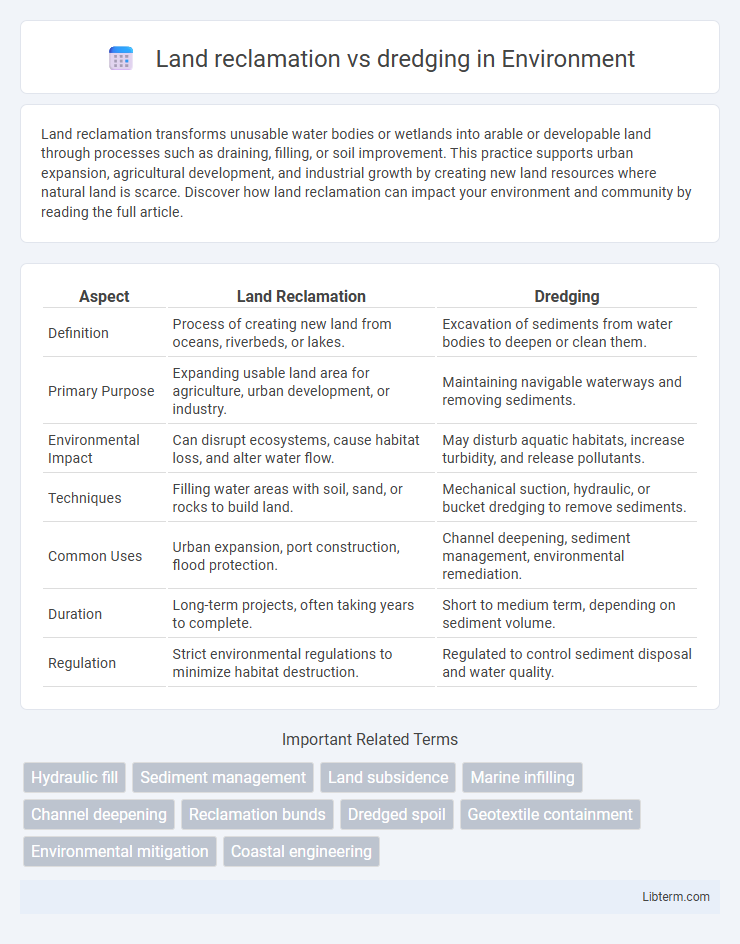Land reclamation transforms unusable water bodies or wetlands into arable or developable land through processes such as draining, filling, or soil improvement. This practice supports urban expansion, agricultural development, and industrial growth by creating new land resources where natural land is scarce. Discover how land reclamation can impact your environment and community by reading the full article.
Table of Comparison
| Aspect | Land Reclamation | Dredging |
|---|---|---|
| Definition | Process of creating new land from oceans, riverbeds, or lakes. | Excavation of sediments from water bodies to deepen or clean them. |
| Primary Purpose | Expanding usable land area for agriculture, urban development, or industry. | Maintaining navigable waterways and removing sediments. |
| Environmental Impact | Can disrupt ecosystems, cause habitat loss, and alter water flow. | May disturb aquatic habitats, increase turbidity, and release pollutants. |
| Techniques | Filling water areas with soil, sand, or rocks to build land. | Mechanical suction, hydraulic, or bucket dredging to remove sediments. |
| Common Uses | Urban expansion, port construction, flood protection. | Channel deepening, sediment management, environmental remediation. |
| Duration | Long-term projects, often taking years to complete. | Short to medium term, depending on sediment volume. |
| Regulation | Strict environmental regulations to minimize habitat destruction. | Regulated to control sediment disposal and water quality. |
Understanding Land Reclamation
Land reclamation involves creating new land from oceans, riverbeds, or lakes by depositing materials such as sand, soil, or rocks to elevate submerged areas. This process is distinct from dredging, which primarily focuses on removing sediments and debris to deepen waterways or maintain navigation channels. Understanding land reclamation is crucial for coastal development, urban expansion, and environmental management, as it transforms underwater or marshy areas into usable land for infrastructure and agriculture.
What Is Dredging?
Dredging is the process of excavating sediments and debris from the bottom of lakes, rivers, harbors, and other water bodies to maintain or increase depth for navigation and construction. It involves the use of specialized machinery such as cutter suction dredgers, trailing suction hopper dredgers, and grab dredgers to remove accumulated silt, sand, and organic material. Unlike land reclamation, which creates new land from water bodies, dredging primarily focuses on sediment removal to improve waterway functionality and prevent flooding.
Key Differences Between Land Reclamation and Dredging
Land reclamation involves creating new land from oceans, riverbeds, or wetlands by depositing soil, sand, or other materials, while dredging focuses on removing sediments and debris from the bottom of water bodies to deepen or maintain waterways. Land reclamation changes the landscape by expanding terrain, whereas dredging primarily enhances water navigation, flood control, and sediment management. The environmental impacts differ, with reclamation altering ecosystems and habitats extensively, and dredging affecting water quality and sediment distribution.
Purposes and Applications of Land Reclamation
Land reclamation primarily serves to create new land for urban development, agriculture, and industrial use by converting water-covered areas into usable terrain. It enables expansion of coastal cities, supports infrastructure projects like ports and airports, and enhances flood control by altering natural water bodies. In contrast, dredging focuses on maintaining and deepening waterways for navigation, sediment removal, and environmental management without necessarily creating new land.
Environmental Impact of Land Reclamation
Land reclamation significantly alters natural coastal and marine ecosystems, often leading to habitat loss for flora and fauna, increased sedimentation, and changes in water quality. These environmental impacts can disrupt biodiversity, threaten endangered species, and reduce natural coastal protection against storms and erosion. Unlike dredging, which primarily affects localized seabed areas, land reclamation transforms large land-water interfaces, resulting in more extensive and long-lasting ecological consequences.
Environmental Considerations in Dredging
Dredging impacts marine ecosystems by disturbing sediments, releasing pollutants, and increasing water turbidity, which can harm aquatic life and degrade water quality. Effective environmental management strategies during dredging include sediment containment, timing work to avoid sensitive breeding seasons, and continuous monitoring to minimize habitat disruption. Mitigation measures such as using silt curtains and selecting less invasive dredging techniques help reduce the negative effects on biodiversity and water clarity.
Techniques Used in Land Reclamation
Land reclamation techniques include hydraulic filling, where sand or soil is pumped into water bodies to create new land, and vertical drainage systems that consolidate soft soils for stability. Another commonly used method is soil improvement through deep soil mixing, which stabilizes underwater sediments. These techniques contrast with dredging, which primarily involves removing sediments to deepen waterways rather than create new land.
Methods and Equipment in Dredging
Dredging involves the removal of sediments and debris from the bottom of water bodies using specialized equipment such as cutter suction dredgers, trailing suction hopper dredgers, and grab dredgers. Methods vary based on project needs, including mechanical dredging with excavators or hydraulic dredging that uses suction to transport material. Advanced technology like GPS and sonar systems enhances precision and efficiency in dredging operations, distinguishing it from land reclamation techniques focused on depositing fill to create new land.
Economic Aspects: Costs and Benefits
Land reclamation often requires significant upfront investment due to materials, labor, and environmental mitigation, but it can generate long-term economic growth by expanding usable land for urban development, agriculture, or industry. Dredging typically involves lower initial costs focused on sediment removal and waterway maintenance but offers immediate benefits such as improved navigation and flood control, which support commercial shipping and local economies. Both methods contribute to economic development, with land reclamation providing substantial value through land creation and dredging enhancing infrastructure efficiency.
Future Trends in Coastal Development
Future trends in coastal development emphasize the integration of sustainable land reclamation techniques with advanced dredging technologies to mitigate environmental impact while maximizing usable coastal areas. Innovations such as eco-friendly sediment management, precision dredging, and habitat restoration are driving more resilient and adaptive shoreline projects. Coastal planners increasingly prioritize adaptive infrastructure and nature-based solutions to balance urban expansion with climate change resilience.
Land reclamation Infographic

 libterm.com
libterm.com